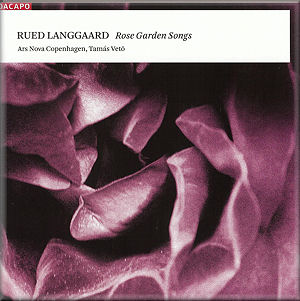 |
 |
|


alternatively
CD:
AmazonUK
AmazonUS
Download: Classicsonline
|
Rued LANGGAARD (1893-1952)
Choral songs with secular texts
Lokkende toner, BVN 112, version b (1916) [5:39]
Sæterjenten, BVN 114 (1916) [3:12]
Høstfuglen, BVN 141A (c. 1918) [9:21]
Rosengaardsviser (Rose Garden Songs), BVN 164 (1919)
No. 1, Vel må jeg kysse dig, hjertenskær [3:02]
No. 2, Bag muren sidde de roser små [5:36]
No. 3, Træt [2:03]
Motets and hymn melodies
O, Gud ske lov; det hjemad går, BVN 65, version a (1914/36) [2:11]
Når engang i fjerne tider, BVN 90 (1915/40) [3:09]
Gid du ville sønderrive, BVN 310 (1945) [1:08]
Hymne, BVN 295 (1943) [2:05]
Den store mester kommer, BVN 175 (1922/24/42?) [2:03]
Døden er den sidste fjende, BVN 239 (1938) [2:44]
Tordner det fra mørkets sky, BVN 423 (1951) [0:51]
Ophøj dig, Gud, BVN 294 (1943) [2:00]
Tusind år stod Kristi kirke, BVN 345 (1948) [2:17]
Den store mester kommer, BVN 240 (1938) [1:39]
I morgenen, BVN 428 (1945/51) [1:37]
In memoriam Ansgarius, BVN 286 (1943/44/48) [3:25]
Op, I kristne, ruster eder, BVN 290 (1943/c. 1951) [2:30]
Døden er den sidste fjende, BVN 240 (1938) [2:16]
Når livets pilgrimsvandring går på hæld, BVN 323 (1947)
[3:05]
Den ypperligste vej, BVN 390 version b (1949) [2:27]
 Ars Nova Copenhagen/Tamás
Vetö Ars Nova Copenhagen/Tamás
Vetö
rec. February 1997, St Matthew’s Church, Copenhagen
 DACAPO 6.220561 DACAPO 6.220561  [64:31] [64:31] 
|
|
|
This is by no means a new disc. It was recorded back in 1997
but makes a valuable and valued SACD reappearance here over a
decade after initial release. The Langgaard ‘problem’ (if
there is one) does not exist here, in a disc which strikes a
tripartite programmatic pose: the c.1916 choral songs to secular
texts, the Rose Garden songs, and finally Motets and hymn
melodies. Suffice to say that the performances are exemplary
in their tonal beauty and in their captivating rhythmic assurance;
glorious singing and direction from first note to last.
The section devoted to the Choral songs opens with one of the
most rapt and beautiful settings in the selection, Lokkende
toner, with its repeated refrain and sense of lyric mellifluousness.
It’s utterly beguiling and a fine place with which to appreciate
the somewhat Delian harmonies implicit in Langgaard’s writing. Sæterjenten is
a faster grained setting, and makes an apt contrast between Lokkende
toner and the last of the three, Høstfuglen which
is notable for its poignant, indeed bittersweet harmonies.
The three Rose Garden songs are equally lovely, and fragrant.
The repeated figures of the first give it a swirling, circular
inevitability; that hypnotic return strikes a note of rapt inevitability
- there’s something elemental about his deceptively simple
writing, except that the musicians make it sound simple.
The bright, warmly affirmative second setting, Bag muren sidde
de roser små is another warming example of his affirmative
settings.
The rest of the disc, the majority, is given over to Motets and
hymn melodies. These vary from the beneficent to the more
obviously inspirational Langgaard. An example of the latter is Gid
du ville sønderrive from 1945 with its rich harmonies
and approach. By contrast something like Den store mester
kommer embodies the simple but not simplistic virtues of
the hymnal impetus. These seldom if ever cloy in his settings.
If one suspects that the 1938 setting of Døden er den
sidste fjende is straying in this direction, then be assured
that Langgaard’s expressive arsenal of harmonies ensures
that things remain alive and supple. Such sturdy melodies as Tusind år
stod Kristi kirke and Op, I kristne, ruster eder are,
in fact, some of the most lovely and direct things here, and
it’s this sense of directness, honesty and meeting one’s
gaze, musically speaking, that embodies all these settings. I’d
cite Døden er den sidste fjende as possibly the
most explicit example of that quality in this selection.
The booklet documentation includes full texts, and the SACD sound-stage
adds to the sense of perspective and depth. In every way then,
this is a lovely disc.
Jonathan Woolf
|
|

